


A dome protected weather radar just south of Minamitane is part of a weather station for Tanegashima Space Center. Feb 23. Tanegashima, Japan. Credit: NASA/Ellen Gray
I hear it was snowing in Maryland last night/today. In my inbox this evening (East Coast morning), I got the boilerplate message that while Goddard Space Flight Center is open on Feb. 26, non-critical and non-emergency personal could telework or take leave to avoid the snowy roads. The GPM team members scheduled to be on console for Thursday’s launch of the Global Precipitation Measurement Core Observatory are definitely critical.
As I write this in Tanegashima, I’ve been listening to a rainstorm blow across the island. Earlier, the wind was so loud outside of the Spacecraft Test and Assembly building where the GPM project offices are that Michael Starobin and I were worried about driving back to the hotel. The roads are narrow and twisty, which is bad enough after dark when we have drive on the opposite side of the road than we do in the States. Fortunately, when we walked outside the heavy rain we feared hadn’t hit yet, but the wind was wind you lean into.
Weather is one of the deciding factors for when a launch actually happens. It’s also the most fickle. Today, the first launch weather report was issued at Tanegashima Space Center at the Launch Readiness Review, the last major review panel of NASA and JAXA officials who gave GPM a go for launch on Feb. 28 (Feb. 27 in the U.S.) with an updated launch window beginning at 3:37 a.m. (1:37 p.m. EST).
Despite the rain here, the weather forecast for liftoff looks good. From the official update: “Weather at T-0 is forecast to be some scattered clouds with light winds, neither of which are expected to affect launch. Winds at launch are forecast to be 13 mph (violation is 47 mph).”
In about 28 hours, we’ll be watching a relatively clear night sky light up.
For those following along at home, live coverage of launch will begin at 12 noon EST on NASA TV. You can watch streaming online at: http://www.nasa.gov/nasatv
Greenbelt, MD
84°F High 74° F low Sunny
The transition from a remote-area scientific expedition to everyday life comes fast and hard. Even though the flight from Tura to Baltimore consumes over 24 hours, those are the last slow moments that the scientist will experience. The moment the aircraft touches down, the race begins. It is a race not only to recover a daily routine that has become foreign while in the field, but also a race to catch up on the set-aside responsibilities of family and friends, and everyday life.
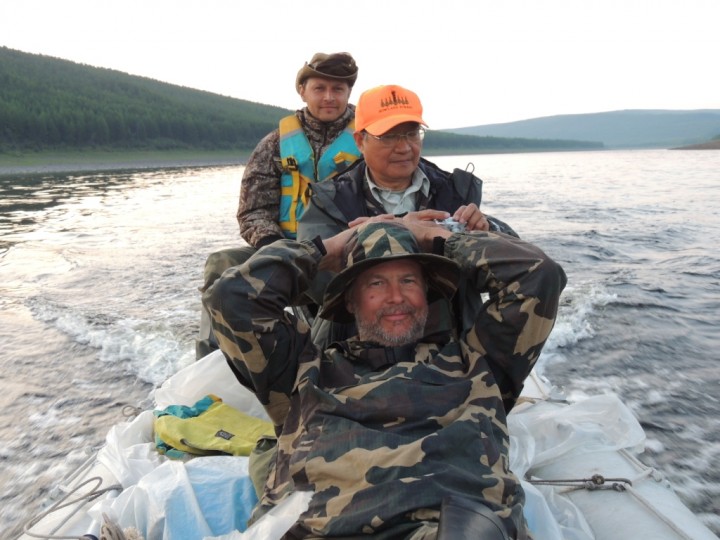
The scientists relax on the Kochechum River on the last day of the Siberia 2012 Expedition. The last day was long, but peaceful. When they arrived in Tura, they heard the news that the rivers were so low that ships that supply the town could not navigate the rivers, so many supplies in the town were running low. From back to front: Pasha Oskorbin, Guoqing Sun, Ross Nelson.
On the Embenchime, life was simple and direct. In Siberia all efforts were focused on food, shelter, transportation, and making scientific observations and collecting data. But in America, life is fast, distracting and complex. From the moment of return, there are bills to pay, meetings to attend, past due work to accomplish, and so much more. The clamor can be overwhelming. It takes several weeks to emerge from the transitional hubbub.
Our scientists left the dry Siberian rivers on July 22, and the American contingent returned home shortly after. Jon Ranson and Ross Nelson stepped off the airplane from Russia late on July 24, and were back at their office jobs early the next day. Gouqing Sun took a short amount of personal time in China to visit relatives before returning to America about a week later. Now, nearly three weeks later, the scientists finally have a moment to recap their days on the Embenchime. Dr. Jon Ranson and Dr. Slava Kharuk send the following closing thoughts.
From Dr. Jon Ranson:
Our travels for the 2012 Siberia expedition are now complete. Everyone has returned to their families in Russia or the United States. Life as we know it is returning to normal. I have lots of memories (and field books full of observations) of the many faces of the larch forest in Siberia. But the common face of the forest can be summed in one word: change.
Whether viewed from helicopter, boat or on foot, huge areas of forest show the effects of fires. Some fires are recent, but most burned a couple of decades in the past. Because of how remote those forests are, and given the absence of people, most of these fires were likely caused by lightning. In many places the larch forest regrows, in some places it does not. We thought we understood how larch forests regenerated, but this change we’ve seen – some stands do not appear to be regenerating – certainly calls for study.
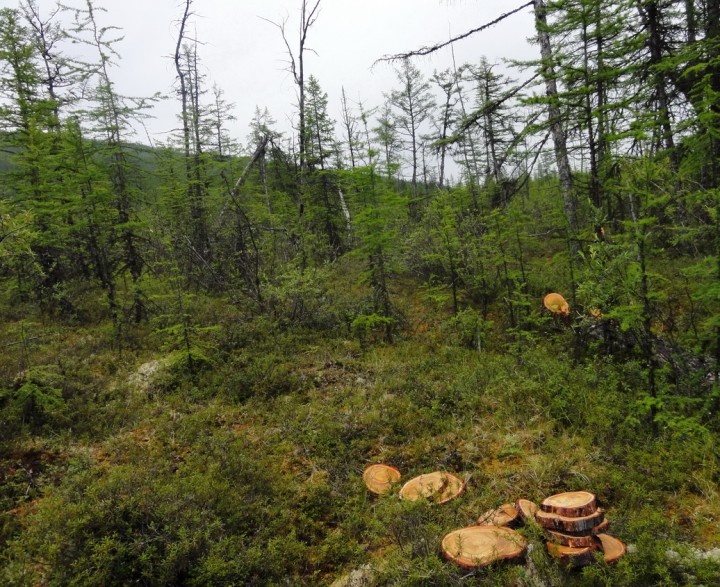
One of the changes observed in the larch forest was the significant amount of burned area. Fires appear to be returning to these forests more frequently than they have in the past. The samples collected on this expedition (in the foreground) will help quantify the fire-return intervals in the Siberian larch forest.
In any given area, there has been a trend for less time between fires – the fire return interval is changing. Professor Kharuk’s additional analysis on the fire scar samples will quantify this trend. Change is also occurring in the form of soil slumps and landslides as thawing permafrost allows whole hillsides of forest to slide down into the river. More subtle changes are the accelerated growth of individual trees in this area from the warming climate. Our field data should reveal and help quantify those changes. Our task ahead is to develop methods that take what we are learning about the larch forests in these central Siberia expeditions and apply it to the whole of the forest with aircraft and satellite remote sensing. Then we will know better the extent and the consequences of these changes.
This is our ninth joint expedition with our Russian colleagues in the Siberian forests. These expeditions take a lot work in planning, in executing the expedition on-site, and then in analyzing the data. Success depends in large part on uncontrollable things like airline schedules, weather and durability of equipment. But the primary key to success is the dedication of the expedition team – each scientist must fully commit themselves to stay focused on our goals and to overcome whatever challenge comes our way.
The joint scientific effort between NASA and Sukachev has endured for over two decades mostly because of the commitment of the scientists involved. Everyone, (including our sponsors) understands the scientific importance of gaining firsthand information about these forests, and everyone is dedicated to making the most of this opportunity. In addition I think we all have a sense that these expeditions, while challenging, can be seen as an adventure, and are essential to help us to be “grounded” in our science when back at the office.
We appreciate everyone who has looked in on this blog, and who have followed our personal and scientific journey on the Embenchime this year. There is much more work to do in this region – and we will return next year. In 2013, we will not only be making ground measurements, but we will also be flying multiple instruments (lidars, and hyperspectral and thermal cameras) to help us better quantify the changes in the larch forest. We hope that you will come along with us, again, via the Earth Observatory.
From Dr. Slava Kharuk:
This was our third remote river expedition with NASA’s scientists to larch dominated communities. We crossed larch forests by boating on Embichimo River. Helicopter and boat are the only means to get the study area. The Embechimo is a consequence of rapids, rough waters and “lake-like” surfaces, with underwater boulders which lie in ambush to crush boat engines. Our only hopes for relief were additional water from tributary rivers.
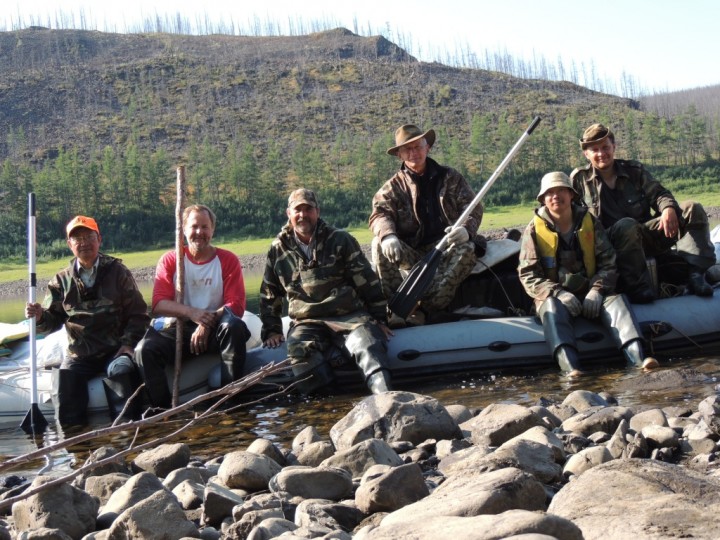
The 2012 Siberia crew at the end of the expedition. From left to right: Guoqing Sun, Ross Nelson, Jon Ranson, Slava Kharuk, Sergei Im, Pasha Oskorbin. This team plans to return to the region in 2013, bringing new instrument technology to help collect data required to understand the changes which are occurring in the larch forests of Siberia.
But those tributaries were almost dried out: hot! It has been unusually hot … and so many forest fires, too. “Dry” thunderstorms caused fire ignitions over a millions hectares. The landscapes along the route were regenerating burns of different post-fire ages. We saw successions from seedlings embedded into “battle field” of mortal trees up to mature forests. The history of these “battles” was imprinted in burnmarks on the surviving and dead boles.
Warming-induced fire frequency increase may convert Siberian taiga from the sink to the source of carbon dioxide (at least at short time intervals). Also, fires promote larch domination, since conquered species are less fire-resistant. Warming also increases seasonal permafrost thawing depth and soil drainage, prolonging vegetation period, and, consequently, promotes an increase in larch growth. White-hot Arctic Circle sun irradiated energy is similar to Amazonian sun during polar days. But warming also provides opportunities for the “southern species” (Siberian pine, spruce, fir, birch, aspen) to migrate into larch habitat.
In a changing climate, larch forests contain a number of challenging questions. To answer these questions, expedition studies and in-lab analysis are needed.
Since the expedition has passed, my dreams are still about larch forests, fire burns, moose and caribou watching with wide-open eyes the approaching expedition boats… and a nightmare of rough waters, rapids and hidden underwater boulders. We will return once again, next year.
Kochechum River 64°42’31’’M 100° 54’ 14’’ E
10:19 p.m. Siberia 10:19 a.m. EDT
79°F High 48°F Low Sunny
Dr. Ranson reports:
We have finally just landed on a camping spot, after a long day on the Kochechum. We spent about hours on the river today. Last night’s camp was about 100 miles upriver – a good day’s journey, by any account.
This morning came early. We were up and working by 7:30, stowed all our gear, had a breakfast, and were on the water by 9:30 in the morning. We have a lot to do before we can roll away from camp, so we really did move fast.

The scientific team on the Kochechum River, pausing for a moment on their race to Tura. From left to right, Guoqing Sun, Ross Nelson, Jon Ranson, Slava Kharuk, Sergei Im and Pasha Oskorbin. Behind the group is a basaltic hill, with a forest killed by fire. A small regeneration is apparent under the dead trees. A band of healthy larch, unburned by fire, lines the river bank.
The biggest news is that the Kochechum is amazingly low. We were here in 2007, and I remember the Kochechum as a very big river, that was fast and high. When we came into the river yesterday, it surprised me. The Kochechum looked small, and the Embenchime looked like the biggest river of the two! The current on the Kochechum is slow, and we are fighting the rocks. We had to pull our boats across at least one area on the Kochechum today. That’s not at all like 2007. This year, the Kochechum is thirsty.
Our campsite, however, is wonderful. It’s actually sandy here. It’s the first night we aren’t sleeping on rocks – that will be really a joy, and I expect to sleep well.
There are some decent looking forests along the Kochechum, with tall trees and dense forest cover. The forests upriver were more scraggly, with fewer trees and apparently slower growth. I’ve noticed that the trees along the river are taller and stronger looking. We’ve seen this all along – that there is robust growth right near the river, but behind the riverside band the forests are thinner, shorter and there are burned areas. The fires do not seem to burn the trees right on the river, but have affected the dryer forest away from the river beds. This far down the Kochechum, the band of healthy forest next to the river is deeper than on the Embenchime, that’s one thing we’ve noticed.
Today we saw our first caribou. We’ve seen moose upriver, but not downriver. And we’ve seen some caribou antlers on the ground upriver, but no living caribou until now.
Just before we came to tonight’s camp, we passed a very large area that seems to have burned very recently. We saw a gray hillside, but we couldn’t see any regrowth. I think we’ll have to carefully look at the MODIS and LANDSAT historical imagery of this area before we return next year, so we can understand when the fires may have occurred, and take a careful look at the land cover from those satellites.
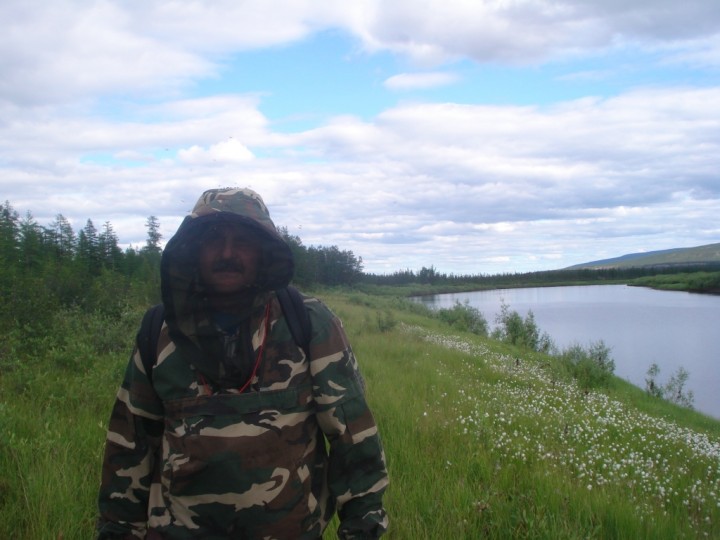
Dr. Jon Ranson, on the Embenchime River earlier in the trip, wears standard mosquito protection. On this trip mosquitoes were ever-present, but not as thick as years past. Instead, green-headed biting flies became a major annoyance.
The weather is brilliant today. Apparently there is high pressure over our heads, so we are in sunshine with no clouds, and no rains. Unfortunately it is very hot. Near 80°F – this is Siberia, not Maryland. It’s surprisingly hot. I don’t know if I recall feeling quite as hot in previous trips, but I don’t know for sure. I can say, however, that the heat is remarkable. When we are boating, we have a 10 km per hour breeze, and that is quite welcome.
There’s not a lot to do when we are well underway, and the water is deep enough that we don’t have to fight the rocks. So we find ways to pass the time. We look at the scenery and make observations. We try to talk, but the motors make enough noise that it is difficult, so mostly we find solitary ways to pass the time.
Guoqing finds a way to enjoy his surroundings, wherever he may be. He has been studying the pebbles around here, and has collected a few interesting ones. As we were traveling downriver today, he arranged his pebbles in an intricate pattern on his boat. It really looks cool – a little art in the wilderness. And it speaks to how much he connects with his surroundings. He’s a very hard worker in the field, and seems to have a good time, all at once.

The scientists were looking forward to reaching the Kochechum River, where they expected water to be deep and current swift, helping push them on their way to Tura. When then arrived at the confluence, however, it appeared that the Embenchime carried more water than the Kochechum. The low waters have made navigation difficult from the first day of their journey.
Ross and I have a different approach to time in the boat. In years past, the mosquitoes have been blood-sucking ferocious, and extremely plentiful. I finally learned to bring a flyswatter along, to use each night in my tent. I could swat away all the buzzing irritants before I tried to sleep. I mentioned this to Ross today, and he immediately wanted to see my flyswatter. So I dug into my gear, and handed it over.
Mosquitoes have not been a huge problem, this year, especially on the river. But we’ve been pestered with green-headed biting flies. I don’t know what they call them, but I know we have had various less-than-friendly names for them. Today, however, we’ve had our revenge. Ross has been primary on the swatter, and seems to enjoy hunting them as we chug downriver. I’ve had my hand in it, too, I have to admit. The flies really should learn to leave this boat alone.
We also did some laundry again today, dragging the clothes between the boats, where the turbulent water acts like a washing machine. I now have nice clean socks and a clean shirt, too, so that when I get to Tura I can look a little respectable.
Sergei and Pasha seem to be good friends, as well as hard working colleagues. They make sure the boats stay in working order, are our primary cooks, and keep the camp running smoothly. At night, I hear them chatting amiably in Russian. I can’t tell what they are talking about, but I get the idea much of it is about their families and their young children. They have a lot in common, and the friendship is evident, in any language.
We all get along well. Despite the hard work, the austere conditions, and the exhaustion we experience from time to time, there has been no fighting, no drama here. We enjoy each other, enjoy our work, and manage to have a good time, when the opportunity arises.
I just got the call to join dinner. We’ll eat, then head to bed. Tomorrow we will leave here early, and plan to forge on to Tura, no matter how long it takes. The prospect of a hot shower and a soft bed is quite appealing – we’re ready return to civilization.
Embenchime River 65°16’35’’N 101°9’21’’E
11:00 p.m. Siberia 11:00 a.m. EDT
78° F High 49°F Low Sunny
Dr. Ranson reports:
We hopped out of our tents early this morning, broke camp, grabbed a quick breakfast and headed into the forest to make our measurements. We were in the woods by 8:30 this morning, and didn’t return until around 5:30 this evening. A nine hour workday – that should be enough for anybody. But expedition days are long, long days.
Once we returned to camp, we ate a quick dinner, loaded up our boats, and headed downriver. Three hours later, we found a spot to sleep, unloaded the boats, set up an overnight camp, and had a little late-night dinner. After a long day in the woods, we have begun our race to Tura. The plane to Krasnoyarsk leaves on Monday – and we intend to make that connection.

The day’s work included making tree measurements along GLAS footprints, collecting samples for fire-return studies, and then spending hours on the river, heading to Tura. Here Slava and Sergei work collecting samples for fire return studies.
Today we left our last camp on the Embenchime. Tonight we’re camping on the Kochechum River. We were on this river in 2007, and our last two days will be spent retracing the last days of that Expedition. It will be interesting to see if there are noticeable changes.
Today we had quite a lot of measurements to make. We walked the lines where the GLAS instrument on the ICESat satellite had collected data, and we planned to measure all of the GLAS footprints. We discovered that some of those footprints fell in burned areas. That wasn’t a total surprise, but we found that in several of those plots, there were no trees at all to measure. The fire had taken everything, and there was no regeneration at all. In other GLAS footprints there had been fire as well, but also some reproduction. In those plots, we took made our standard measurements.
Slava collected some fire-return data, including several discs in the general area. He said that, based on his quick field examination, the last fire here had burned about 25 years ago. If that is accurate, then there has been remarkably little regeneration here over the last 25 years. Larch grows very slowly, and they don’t take up a lot of carbon until they get big. We cut one tree that was 7-8 feet tall and it was only 17 years old.
The fires here appear to have been really extensive, as well as really frequent. In some locations, there are drainage ditches and wet areas, and in those wetter areas stands of older trees have resisted fire and survive. These survivors provide a source of seed, so some regeneration is occurring. And many stands show normal heavy regeneration after the fires. However, the lasting impression I have of today’s work is walking in the burned areas, and seeing very little regeneration in some of them. Such a thing is so unexpected that it was an amazing, and sobering, experience.
As we’ve traveled downriver, my mind keeps turning over what I’ve seen. The lack of regeneration in some of these areas challenges the traditional notion of vigorous regrowth of larch after fire. It also has bigger implications in regards to the forest response to a warming climate. I do not think we really understand what is going to happen to our boreal forests, and how the fate of the boreal forests will affect our Earth and our own lives, in a warming climate.
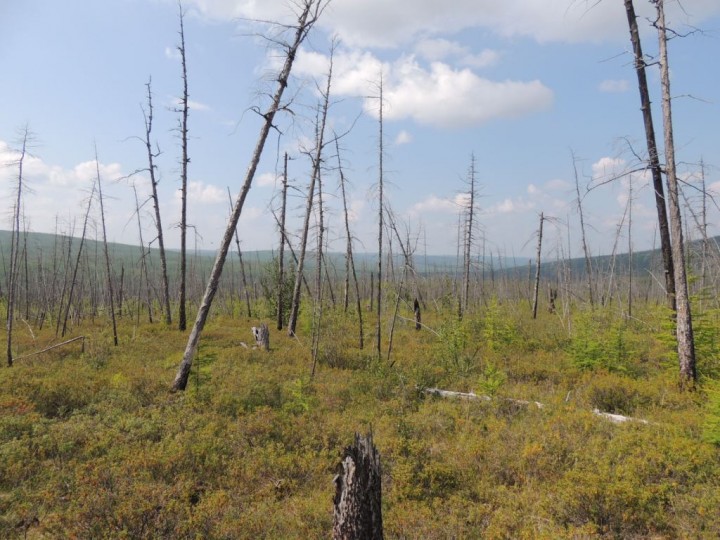
After a fire, larch stands tend to reproduce very vigorously. In some of today’s plots, reproduction was very sparse or nearly non-existent. The last tree-killing fire in this area was estimated to have passed about 25 years ago – but in that time, no larch has regrown. This finding may challenge traditional thinking about the dynamics of larch forests after fire, and brings forward questions about the effect of more rapidly returning fires on the reproductive ability of larch forests.
The traditional notion is that the boreal forests, especially these larch (larix gmelinii) forests, live in a rather symbiotic or at least balanced relationship with fire. It is accepted that fire helps larch regenerate by improving the soil to make it more favorable for larch seed germination, and by reducing competition, allowing for the rapid growth of larch saplings. Also, mature larch form a thick, fire-resistant bark, so most fires allow mature trees to remain, so seed sources are preserved.
What we saw in the northern forests was compatible with this traditional hypothesis. We saw burned stands with thick regeneration. And in the northern forests, the burning seemed to be somewhat controlled, because small areas of the forest were dry, with wet areas right next to them. It appeared that the dry areas would burn, but the wet areas might tend to control fires, so vast hillsides were not destroyed at one time. Also, we know from several studies that in the northern boreal forest fire return interval in any one stand is very long. All this, put together, means that small areas of forest burn regularly but infrequently, leaving time for replacement trees to grow back to adult size, so they become seed sources long before the next fire comes through. It also means that mature trees survive nearby to the burned area, and they could provide an immediate source of seed. However, as we move south, in this area, we seem to be seeing, in at least some areas, a failure of regeneration after fire. That is a very troubling thought.
The theory is that these forests are generally a carbon sink for the world – they are growing, and as they grow they absorb carbon. They hold carbon in their roots and trunks, binding it and helping keep it out of the atmosphere. We know that when forests burn, carbon is released, and at that time, the forests are a carbon source. However, the thinking is that the regeneration is so strong afterwards, it allows the rapidly growing trees quickly to absorb a lot of carbon, so that even with intermittent forest fires, the boreal forests remain a sink.
There also seems to be an assumption that as the climate warms, and as permafrost thaws, that the soil will be more favorable for tree growth, so the trees will become bigger and more robust. This should, theoretically, allow the forest to take up even more carbon, and potentially mitigate, to some degree, the effect of warming. This all makes sense – but we do NOT know, for sure, if it is true.
Based on what we see, I’m not really sure we can assume the traditional notions. It is clear that in a warming climate, the forests become dryer and fire returns more often. Even with strong regeneration, fire has a limiting effect on the size of the forest, however. It is really not clear if the forests will ultimately be bigger and faster-growing in a warming world, or if fire will limit the growth potential of these forests.
If fire returns quickly enough to kill off trees before they reach sexual maturity, then it may well be that we lose the regeneration – and without new trees, we won’t have replacement forests to uptake the carbon. A lot of current climate theory is counting on regenerating and growing forests to take up carbon, to mitigate the effects of warming. But what if rapidly returning fires end up killing off the forest before the trees are old enough to reseed? We need to consider this possibility in our modeling of carbon, and include the potential impact of such a scenario.
In addition, there is a lot of data that suggests that as permafrost melts, it doesn’t just become more fertile soil for tree growth. As the ice melts, the highly organic soil begins to decompose. Decomposition of permafrost releases carbon as well as methane – both powerful greenhouse gases. It may well be that in a warming climate, when a tipping point is reached, these forests may not only be unable to mitigate the effect of the carbon we humans pump into the atmosphere, but may also become a source of carbon and methane from both thawing permafrost and repeated fires. I don’t know what will happen – but we need to take a hard look at these issues, and soon.
Ross and his group worked on the south side of the river today, and found a lot of burned areas there, as well. He, too, found little larch reproduction. So what we have both found is that the larch is not reproducing well here. On both sides of the river, it appears that fire is returning more frequently, and that they may not have time to reach seed-bearing age before fire returns. If there is no seed available, because the fire returns too soon, then the next generation of larch may be wiped out.
Interestingly, what Ross did find was that birch was growing fairly well in some burnt areas, where larch was not regrowing. We found a little birch on the north side of the river, as well, but not as much as Ross has found on the south side. I’m not sure what this means, but it is different than what we are used to seeing. We are used to seeing strong larch regeneration after a fire – and there is some evidence that it does not always occur.
We all need to consider this finding carefully – it challenges our comforting hypothesis that the forests will be able to mitigate climate change. To a point, we can expect to forests to help. But when the climate is so warm and dry that fire returns to an area quickly – I don’t think we really know what will happen then. It is possible that under rapidly returning fire, the forest may not be able to maintain itself. We really need to study these questions earnestly – and quickly. It is truly important for us to understand what is happening to our home planet, our beautiful Earth.

The last camp on the Embenchime River. From here, the scientific team begins their return to Tura. As they join the Kochechum River, they look forward to finding higher water and faster current to speed them on their way back home.
The forests here have a great deal of diversity, especially in response to fire. It’s really valuable to see this diversity, and to be able to make measurements in all the various types of regeneration situation. We’ve seen a few plots with very little regeneration. To understand what this means, we need to gather data to find out if this is occurring in rare areas, or if this lack of regeneration is occurring in widespread areas. Remote sensing, either by satellite or by our G-LiHT instrument, is going to prove very useful to help us understand these forests. I am looking forward to getting back out here next year, with our instrument package, and applying it to this year’s data.
For us, tomorrow will be another big day on the river. We’re in a race against time, a race to Tura. Slava is working on the boats now, putting a new propeller on the motor. He thinks the river is deep enough to use a better propeller – one that hasn’t been beaten up by rocks already. The old propellers have been kept running – Sergei and Pasha file the blades down each night, to smooth out the areas damaged by rocks during the day. The old propellers are working, but the new should help us gain a little speed.
It seems like a really long way to go, but the river is faster, the water is higher, and we are excited to be heading towards home. It’s not easy travel. Every time we come to a turn, Slava slows everything down and we have to look at the waters carefully. We don’t want to run headlong into shallows and tear the boats. Even in the Kochechum, we all too often have to jump out of the boats and pull them through the shallows. But we’re on our way back. We will be in Tura, soon.
Embenchime River 66.34 N 100.63 E
11:30 p.m. Siberia, 11:30 a.m. EDT
78°F High 52°F Low Partially cloudy
Dr. Ranson reports:
I am tired tonight. Actually, I think everyone is tired, because it was a very long and intense day. The day started early. Really early. As in, today’s work started late last night.
As we came downriver yesterday, we found a great little campsite, settled into it quickly. It was a gravel bar in the middle of the river. The rocks weren’t all that big, and that made it pretty appealing. The smaller the rocks, the easier it is to sleep. The view of the river was really sweet, too. We set up camp in happy anticipation of a beautiful, restful night.
We set up the campfire near the river’s edge, and Pasha and Sergei started cooking dinner. We went and set up our tents. We did notice the water was starting to rise, but it was slow and we weren’t very concerned. There hasn’t been much rain around here, so we didn’t think the river would be any issue. We decided we’d just pay attention and watch it, just to be sure.
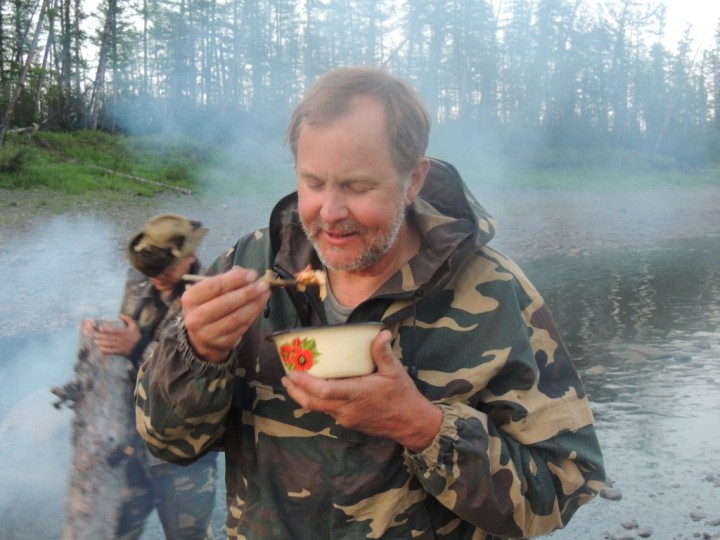
Ross enjoys the first bites of his dinner, using chopsticks he crafted from willow branches. Behind him smoke billows up from the campfire, as a rising river begins to douse the fire.
Just before dinner, Ross realized he’d misplaced his spoon somewhere, and he couldn’t find it. He really did want to eat, so he found his knife, went out and collected two willow sticks, then cut them up and cleaned them to make a very nice pair of wilderness chopsticks. He was pretty proud of himself, and happy to be able to eat dinner. We were all laughing and making fun of him, and I was taking pictures. No one was paying attention to the river. As Ross posed, I took a nice photo – then we all noticed there was a big gray bank of smoke rising up from the campfire. The Embenchime had risen abruptly and was dousing our campfire!
We all jumped up and moved everything up to the middle of the sand bar, which was quickly becoming an island. Satisfied that we were on high enough ground, I went into my tent to try to download pictures. As I worked on that, I heard Slava walk by, stop at my tent, and say, very softly, “we will have to move, the water is coming”. I said okay, and kept on fighting the stubborn data terminal. Ten minutes later, as I had victoriously made a connection and the photos were downloading, I heard his voice again. This time his voice sounded very urgent “Jon, the water is now at your tent”! And sure enough – it was just outside. We woke everyone up, and then we had to cross the river and put our tents on shore. It was very late before we got settled back into our tents to sleep.
It wasn’t really a dangerous situation, but it was quite a nuisance and robbed us of sleep. These rivers really do rise quickly. I guess somewhere far upriver, somewhere in the drainage basin, there had been a big storm a day or so ago, and the water was just now reaching us. As we came downstream, Slava had pointed out rafts of foam in the river, where a tributary’s water mixed with that of the Ebenchime. He said that might mean that storm water was mixing in, and the tributary was running very fast, to make that foam. I guess he knows the rivers really well here.

The scientists found this plant growing in the forest today. It is locally called “Mararoshka”, and looks something like a raspberry plant.
The rising Embenchime reminds us, once again, that we are not the ones in control here. The river allows us what comfort she wishes to give – and takes it away again at her own whim.
We had a lot to accomplish today, so despite a sleepless night, we could not sleep in. We were up by 7:00 a.m., and working shortly after. We worked most of the day taking measurements here in Plot 16, came back to camp, then loaded up our boats and moved downriver to Box 17. That’s our last plot for data collection. We’ll work that tomorrow – and we’ll work it hard. We want to measure another 20 plots tomorrow – a big day – then, once again, we’ll break camp and head downriver, heading towards Tura.
The measurements in these last two areas are essential, and we are determined to accomplish this, no matter what. The boats need repair, the river is still moody, the distance is long, there are many, many trees waiting for us and we are very tired – but we are up to the task. We will get it done.
As we travel down this river, we see evidence of fire everywhere. We have seen entire hillsides that appear gray. That’s fire damage – nothing else kills stands so uniformly as fire. The gray is the trunks of the dead trees standing, one after another, row upon row, where a major fire has decimated the forest. In most places there is a green undertone. That’s where the trees are growing back, the regeneration filling in after the fires have passed.
At the last camp, about 10 kilometers up river, Guoqing, Sergei and I worked a line of GLAS footprints on one side of the river, and Ross and Sergei worked a line on the other side of the river, up a hillside. Ross said they measured 3 plots in the fire killed area that was densely packed with young trees. In our standard 30 meter radius plot, they measured up to 200 trees over 5 cm diameter growing there. On my side of the river, however, most of the trees were old, and we saw little fire damage.
We are beginning to see a lot of alder inland today. Up to now, we saw a little alder right on the riverside, but not inland. Where alder grows, it will come in quickly after a fire, even right next to a dead tree. It grows very thickly, too. A vigorous growth of alder can make it very hard to measure a plot, because there are so many trees in an area. Some are less than 5 cm, so we don’t have to measure all the sprouts. But we still have to physically push through the stuff. And we make note of alder growing in our plots, because it will potentially affect the signal we get coming back to our satellite and G-LiHT instrument in these areas.
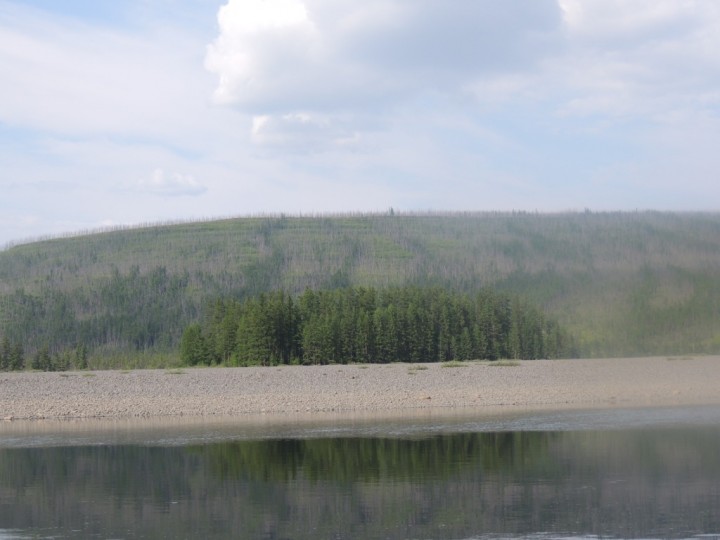
Landscape can control the spread of fire. In the background, the hillside is gray from the trunks of trees killed by fire. In the foreground a robust stand of larch sits on the island. Although the larch was present at the time of the fire, it was protected from the flames by a the small channel of water separating the island from the riverbank.
We also started seeing another, rather odd plant today. It looks like a berry of some sort, maybe something related to our raspberry. It has big leaves and a straight stem, with a berry on top. Slava calls it Marashoka, but I don’t know the scientific name, or much about it. I’ve taken a picture, as it’s a curiosity to me.
When we were at our camp this morning, we heard a lot of thunder. We thought we were going to get rain, but it never showed up. However, the valley upriver of us has filled with smoke. Most of the fires in remote boreal forests ignite when lightning strikes the dry understory, just like this – in a storm without a lot of rain, but with cloud to ground lightning. I guess we must have been distant witnesses to the birth of a wildfire. The fire does not seem close, even though we see and smell smoke. We are in no danger at all. Even if it came near, it is north of us, and we can easily escape on our boats down river. It reminds us, however, of the relationship of fire and the boreal forest. Small fires, which occur regularly but infrequently – are a part of the natural order of things in this region.
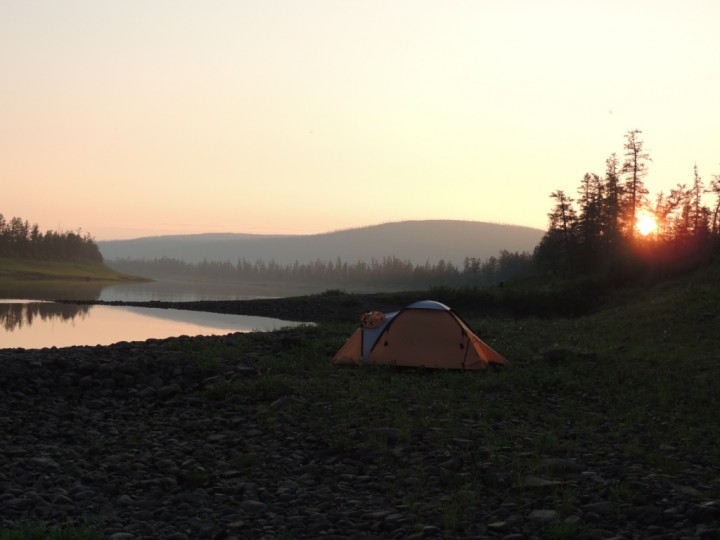
Smoke in the air created a beautiful red sunset. The valley to the north of camp filled with smoke after a passing thunderstorm. Almost certainly, lightning ignited the dry forest floor and gave birth to a new wildfire early today.
There is more spruce showing up as we move downriver. We see more of them, here and there, and we’ve found both larch and spruce cones floating in the river. There is also more interesting observations to make from the patterns of fires in the hillsides here. Clearly, landscape can control where a fire burns. In one spot, we saw a stand of big, beautiful larch sitting on an island in the river. Behind that island of trees, on the riverbank, a large stand of similar –aged larch had been totally decimated by fire. There is no question that the trees on that island would have been alive at the time of the fire. The island was separated from the bank by a small channel – but it was enough. Fire won’t travel over water, so the stand on the island was saved.
Tonight will be our last camp on the Embenchime River. We are just north of the Kochechum, and will join it before we make camp again. We travelled the Kochechum in 2007, on our Siberian expedition that year. We’ll be revisiting the same final section of river as on that trip. It will be interesting to see if there have been changes in the last five years. However, we’re won’t do studies there. We’ll make some comparative observations as we boat along, but no measurements.
We have over 280 kilometers to go before we reach Tura. With the twists and turns of the river, we’ll probably have to travel over 400 kilometers before we are done! Once we reach the Kochechum, we will begin our trip home, and begin to say our farewells to the river. We plan on it taking a full two days to reach Tura, so it will be a long goodbye.